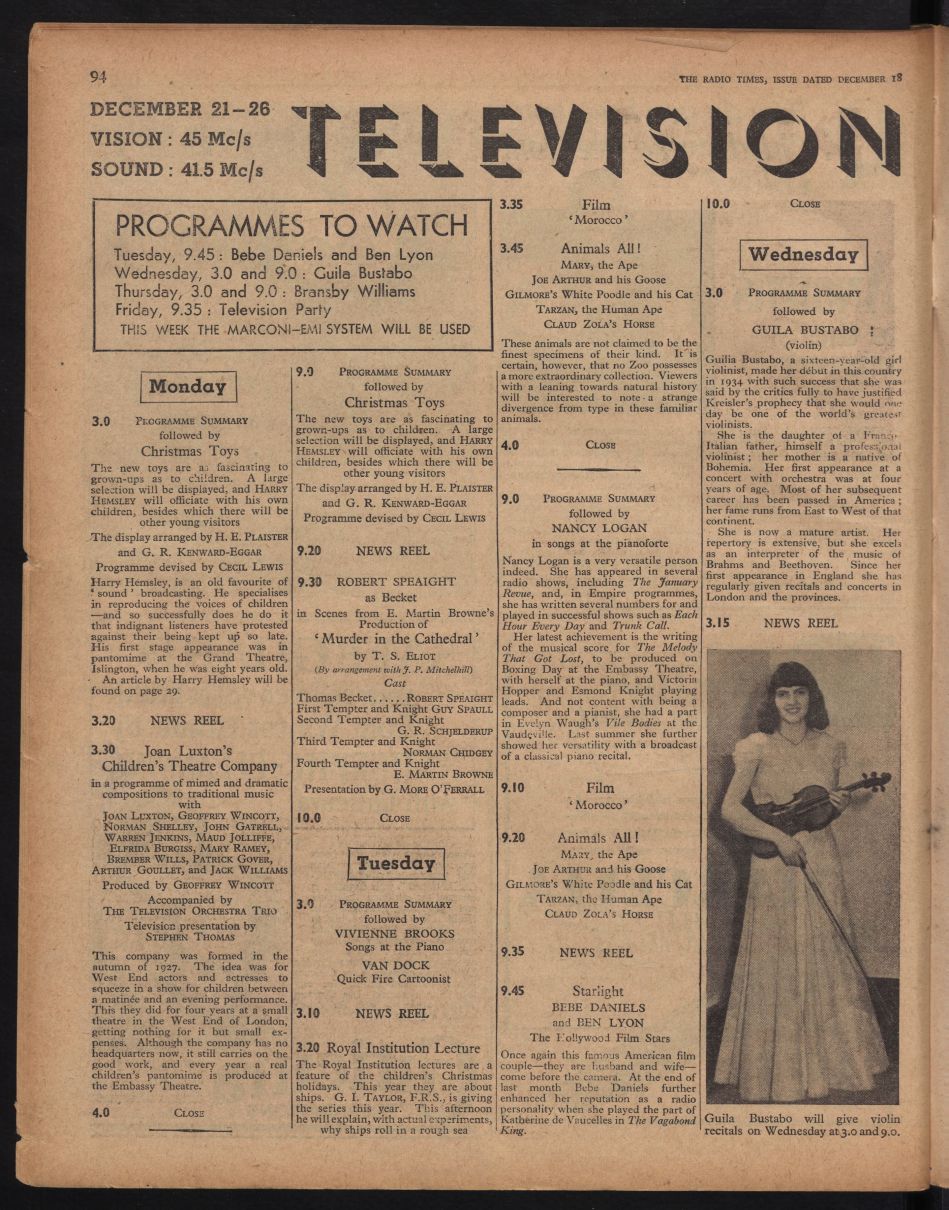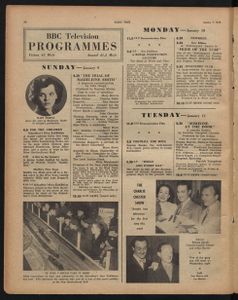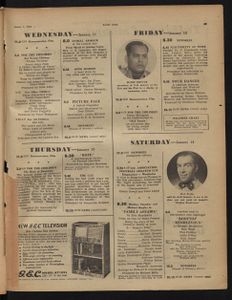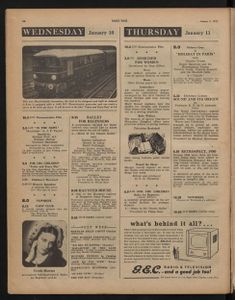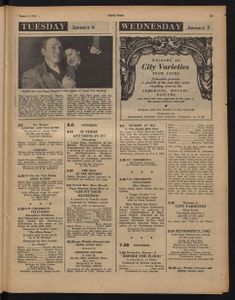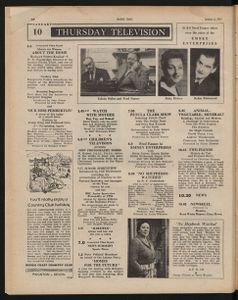Royal Institution Christmas Lectures (lost television coverage of scientific presentations; 1936-1957)
The Royal Institution Christmas Lectures are a series of presentations, which are designed to inspire, entertain, and educate viewers on a given scientific topic. In 1936, Geoffrey Ingram Taylor conducted a series of lectures centring around the topic of ships. He was invited by the BBC to conduct a televised presentation using materials and experiments planned for the Christmas Lectures. This broadcast is considered the first scientific television program to be aired in the United Kingdom, with others having also aired prior to the Christmas Lectures becoming a routinely televised event by 1966.
Background
The Royal Institution Christmas Lectures was first established in 1825 by Michael Faraday.[1][2][3][4] Faraday, who is credited for breakthroughs in electricity such as inventing the electric motor, had conceptualised the presentations initially for to entertain and educate a general adult audience, who back then generally missed out on being taught adequate scientific principles.[1][2][4] Overtime however, its main positive effects centred around children, becoming one of the key institutions to teaching and inspiring the next generation who were then generally devoid of alternative scientific education centres.[2][1] Thus, the Royal Institution Christmas Lectures have been held annually at the Royal Institution in London, with the exception of 1939-1942 because of the Second World War.[2][1]
Among the children these lectures influenced was Geoffrey Ingram Taylor.[5][6] Taylor is credited for his fundamental work on fluid dynamics and wave theory, having been inspired into a career in mathematics and physics by attending the Christmas Lectures, including the 1897 presentations by Oliver Lodge regarding "The Principles of the Electric Telegraph".[5][6] Thus, when he was invited to conduct his own six Christmas Lectures in 1936, Taylor readily agreed, selecting "Ships" as his subject.[7][8][9] Among lecture content included principles of floating, historic ships, navigation concepts, boat designing and modelling, showcasing how yachts move via wind power, and motorboats.[7] Taylor additionally explained the Principle of Archimedes, and also provided various slides that further achieved the aim of appealing to children of various age ranges.[7] He also showcased a diving suit, where one young boy tried and failed to walk in the divers' boots.[8]
Seven weeks prior, the BBC broke new ground by introducing its high-definition Television Service.[10] Prior to Taylor conducting the real Christmas Lectures, the BBC invited him to provide a televised presentation harnessing some of the topics he was set to showcase.[8][9] Instead of performing these at the Royal Institution, these demonstrations instead would be housed at Alexandra Palace, which is where the BBC was conducting its early television transmissions.[8][9] Taylor accepted the invitation, and provided a 15-minute lecture consisting of experiments explaining the reasons behind ships rolling during stormy seas.[11][9][8] The broadcast occurred live on 22nd December 1936, and is cited by the Royal Institution as the world's first scientific television program.[11][9][3][8] At the very least, it was the BBC's first scientific television broadcast.[8]
Other Pre-1966 Televised Christmas Lectures
Between the 1930s and 1950s, the BBC televised special editions of the Christmas Lectures.[12][13][14][15][16][17][3] On 10th January 1949, Frederic Bartlett, the first professor of experimental psychology at the University of Cambridge and influential in the study of memory, provided a special made-for-television seventh lecture at the Royal Institution.[18][12][3] Based around the subject "The Mind at Work and Play", it is unclear what the seventh lecture was about, but it involved plenty of experiments designed to appeal to participating schoolchildren.[12]
On 12th January 1950, Dr. Percy Dunsheath, who presented Christmas Lectures on "The Electric Current", conducted one of two further lectures on electricity.[13][14][3] The other was broadcast the following day, with both again being made-for-television.[14][13] On 11th January 1951, Edward Andrade, a physicist who successfully conducted experiments calculating gamma rays from radium and determine they have smaller wavelengths than x-ray radiation, produced a further lecture on "Waves and Vibrations".[19][15][3] In 1950, he became the director of the Royal Institution, but was forced to resign from the role two years later following a no confidence vote on his planned reforms for the organisation.[19][3] This led to legal issues that temporarily hindered ties between the BBC and the Royal Institution.[3]
After William Lawrence Bragg was appointed as Resident Professor at the Royal Institution the following year, he attempted to mend ties with the BBC.[3] However, Christmas Lectures would only seldom be broadcast for the remainder of the 1950s.[3] On 7th January 1953, Frank Sherwood Taylor, an historian who was then the director of the Science Museum, presented a special lecture for his subject "How Science has Grown".[20][16] Finally, on 10th January 1957, Harry Baines presented some experiments he presented for the subject "Photography".[17] Ultimately, it would not be until 1966 that the Christmas Lectures would be fully televised, as authorised by then-Controller of BBC 2 David Attenborough.[2][3] Since then, the Christmas Lectures have been aired annually, and are currently broadcast on BBC Four.[3][2]
Availability
The BBC and the Royal Institution would later collaborate to provide access to all surviving recorded broadcasts on the latter's website.[21][22] Alas, it also confirms that the pre-1966 broadcasts are all lost to time, as the oldest available airing is from 1968.[22][21] The airings were extremely unlikely to be recorded, as the majority occurred before videotape recording became commonplace in the United Kingdom.[23][24] Radio Times issues helped confirm that the airings existed.[11][12][13][14][15][16][17]
Gallery
Images
References
- ↑ 1.0 1.1 1.2 1.3 Faraday at Home History detailing the creation and purpose of the Christmas Lectures. Retrieved 25th Mar '23
- ↑ 2.0 2.1 2.2 2.3 2.4 2.5 BBC Science Focus detailing the principles and success of the Christmas Lectures, including its appeal to children. Retrieved 25th Mar '23
- ↑ 3.00 3.01 3.02 3.03 3.04 3.05 3.06 3.07 3.08 3.09 3.10 3.11 Royal Institution providing a timeline of Christmas Lectures history, including its connection with television. Retrieved 25th Mar '23
- ↑ 4.0 4.1 Britannica page on Michael Faraday. Retrieved 25th Mar '23
- ↑ 5.0 5.1 MacTutor page on Geoffrey Ingram Taylor. Retrieved 25th Mar '23
- ↑ 6.0 6.1 The Life and Legacy of G. I. Taylor summarising how the Christmas Lectures inspired him to become a scientist. Retrieved 25th Mar '23
- ↑ 7.0 7.1 7.2 The Life and Legacy of G. I. Taylor summarising his 1936 Christmas Lectures. Retrieved 25th Mar '23
- ↑ 8.0 8.1 8.2 8.3 8.4 8.5 8.6 History Extra summarising part of Taylor's 1936 Christmas Lectures, and its television significance. Retrieved 25th Mar '23
- ↑ 9.0 9.1 9.2 9.3 9.4 Royal Institution noting the 1936 Christmas Lectures was the first to be televised. Retrieved 25th Mar '23
- ↑ BBC detailing the opening of its high-definition Television Service on 2nd November 1936. Retrieved 25th Mar '23
- ↑ 11.0 11.1 11.2 Issue 690 of Radio Times detailing the 1936 Christmas Lectures broadcast. Retrieved 25th Mar '23
- ↑ 12.0 12.1 12.2 12.3 Issue 1,317 of Radio Times detailing the 1949 Christmas Lectures broadcast. Retrieved 25th Mar '23
- ↑ 13.0 13.1 13.2 13.3 Issue 1,369 of Radio Times detailing part 1 of the 1950 Christmas Lectures broadcast. Retrieved 25th Mar '23
- ↑ 14.0 14.1 14.2 14.3 Issue 1,369 of Radio Times detailing part 2 of the 1950 Christmas Lectures broadcast. Retrieved 25th Mar '23
- ↑ 15.0 15.1 15.2 Issue 1,417 of Radio Times detailing the 1951 Christmas Lectures broadcast. Retrieved 25th Mar '23
- ↑ 16.0 16.1 16.2 Issue 1,521 of Radio Times detailing the 1953 Christmas Lectures broadcast. Retrieved 25th Mar '23
- ↑ 17.0 17.1 17.2 Issue 1,730 of Radio Times detailing the 1957 Christmas Lectures broadcast. Retrieved 25th Mar '23
- ↑ Britannica page on Frederic Bartlett. Retrieved 25th Mar '23
- ↑ 19.0 19.1 Masonry Today page on Edward Andrade. Retrieved 25th Mar '23
- ↑ Journal of Chemical Education biography on Frank Sherwood Taylor. Retrieved 25th Mar '23
- ↑ 21.0 21.1 Royal Institution announcing all of the surviving broadcasts would be available on its website. Retrieved 25th Mar '23
- ↑ 22.0 22.1 Royal Institution's archive dating back to 1968 as of the present day. Retrieved 25th Mar '23
- ↑ Web Archive article discussing how most early television is missing due to a lack of directly recording television. Retrieved 25th Mar '23
- ↑ Science and Media Museum noting when videotape recording started in the United Kingdom. Retrieved 25th Mar '23
